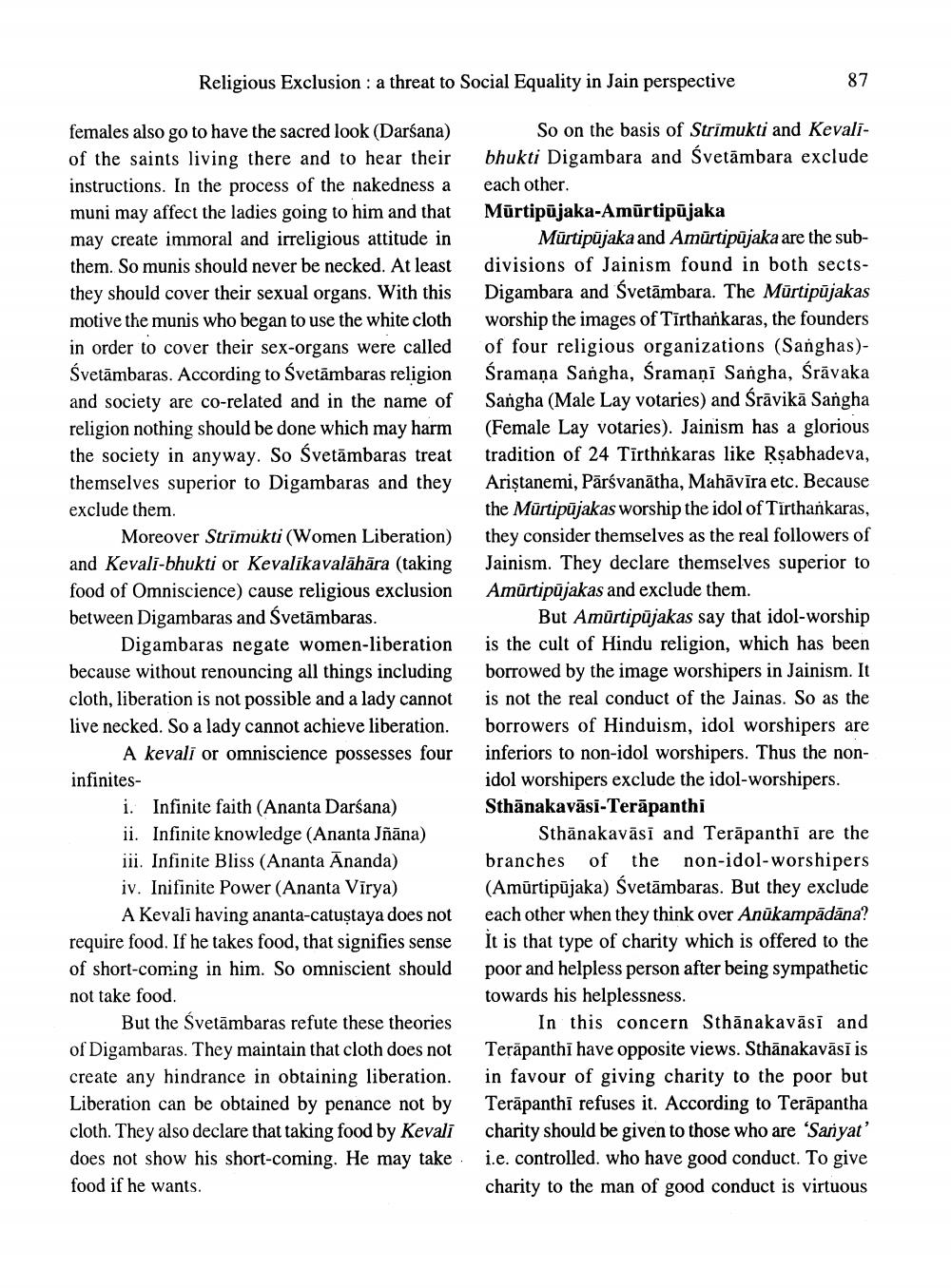________________
Religious Exclusion : a threat to Social Equality in Jain perspective
87
females also go to have the sacred look (Darśana) of the saints living there and to hear their instructions. In the process of the nakedness a muni may affect the ladies going to him and that may create immoral and irreligious attitude in them. So munis should never be necked. At least they should cover their sexual organs. With this motive the munis who began to use the white cloth in order to cover their sex-organs were called Śvetāmbaras. According to Śvetāmbaras religion and society are co-related and in the name of religion nothing should be done which may harm the society in anyway. So Svetämbaras treat themselves superior to Digambaras and they exclude them.
Moreover Strimukti (Women Liberation) and Kevali-bhukti or Kevalikavalāhāra (taking food of Omniscience) cause religious exclusion between Digambaras and Svetāmbaras.
Digambaras negate women-liberation because without renouncing all things including cloth, liberation is not possible and a lady cannot live necked. So a lady cannot achieve liberation.
A kevali or omniscience possesses four infinites
i. Infinite faith (Ananta Darśana) ii. Infinite knowledge (Ananta Jñāna) iii. Infinite Bliss (Ananta Ananda) iv. Inifinite Power (Ananta Vīrya)
A Kevali having ananta-catuştaya does not require food. If he takes food, that signifies sense of short-coming in him. So omniscient should not take food.
But the Svetāmbaras refute these theories of Digambaras. They maintain that cloth does not create any hindrance in obtaining liberation. Liberation can be obtained by penance not by cloth. They also declare that taking food by Kevali does not show his short-coming. He may take food if he wants.
So on the basis of Strimukti and Kevalibhukti Digambara and Śvetāmbara exclude each other. Mürtipūjaka-Amūrtipūjaka
Mūrtipūjaka and Amūrtipūjaka are the subdivisions of Jainism found in both sectsDigambara and Svetāmbara. The Mürtipūjakas worship the images of Tīrthankaras, the founders of four religious organizations (Sanghas)Śramaņa Sangha, Śramaņi Sangha, Śrāvaka Sangha (Male Lay votaries) and Śrāvikā Sangha (Female Lay votaries). Jainism has a glorious tradition of 24 Tirthnkaras like Rşabhadeva, Ariştanemi, Pārsvanātha, Mahāvīra etc. Because the Mūrtipūjakas worship the idol of Tirthankaras, they consider themselves as the real followers of Jainism. They declare themselves superior to Amūrtipūjakas and exclude them.
But Amūrti pūjakas say that idol-worship is the cult of Hindu religion, which has been borrowed by the image worshipers in Jainism. It is not the real conduct of the Jainas. So as the borrowers of Hinduism, idol worshipers are inferiors to non-idol worshipers. Thus the nonidol worshipers exclude the idol-worshipers. Sthānakavāsi-Terāpanthi
Sthānakavāsī and Terāpanthi are the branches of the non-idol-worshipers (Amūrtipūjaka) Svetāmbaras. But they exclude each other when they think over Anūkampādăna? it is that type of charity which is offered to the poor and helpless person after being sympathetic towards his helplessness.
In this concern Sthānakavāsi and Terāpanthī have opposite views. Sthānakavāsī is in favour of giving charity to the poor but Terāpanthi refuses it. According to Terāpantha charity should be given to those who are 'Sanyat i.e. controlled. who have good conduct. To give charity to the man of good conduct is virtuous




